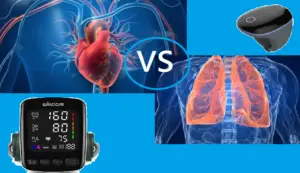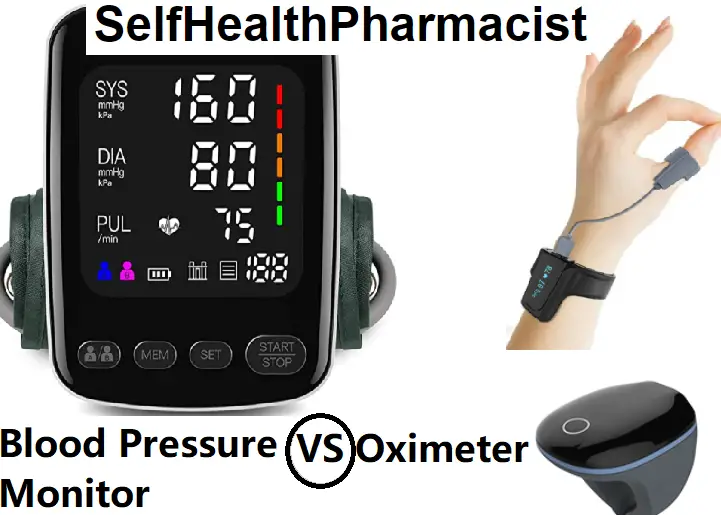Today, doctors are still trying to treat the symptoms of coronavirus.
In case of some complications, more serious measures are already being taken.
One possible complication is a respiratory failure or a low blood pressure. To identify the risk of developing such conditions in the early stages, special devices are used – pulse oximeter or Blood Pressure Monitor.
Among the many common tools used in our first aid kit there are two tools that we are all familiar with but whose real name is little known.
These devices are a sphygmomanometer or simply talking Blood Pressure Monitor that is used to measure blood pressure and also Pulse Oximeter that is used for saturation measurement in your blood.
In Need for A Great Pulse Oximeter?
Let me tell you about the Wellue O2Ring – it’s like the superhero of pulse oximeters, seriously!
One of the coolest things about it is that it doesn’t just clip onto your finger like your average oximeter.
Nope, it’s a smart ring that you wear on your finger, making it super comfortable and convenient. You won’t even feel like you’re wearing anything special, yet it’s working its magic behind the scenes.
What sets the Wellue O2Ring apart from the pack is its continuous monitoring feature.
Most pulse oximeters just give you a snapshot of your oxygen saturation and heart rate, but this bad boy keeps tabs on your levels around the clock.
Whether you’re chilling on the couch, out for a jog, or catching those Z’s, it’s right there with you, providing real-time data.
Oh, and speaking of data, this thing doesn’t just show you numbers – it visualizes your trends over time too.
Imagine having a personal health diary that tells you when you’re acing life and when you might need to take it easy. It’s like having a health-conscious buddy right on your finger!
If you’re already itching to get your hands on the Wellue O2Ring (or, well, your finger in this case), I’ve got you covered.
Check out their official product page here.
Table of Contents
What’s the Difference Between an Oximeter vs Blood Pressure Monitor?
| Oximeter | Blood Pressure Monitor | |
| What’s that? | It is a device that helps to measure the concentration of oxygen in arterial blood, this indicator is called oxygen saturation, or SpO2. | It is a medical device designed to measure the patient’s arterial (blood) pressure. |
| Usage | A pulse oximeter is used in lung conditions to catch the moment when the oxygen level in the blood becomes dangerously low.
All organs and tissues suffer from a lack of oxygen, primarily the heart and brain. |
It controls the indicators of our body, with the help of which our body informs us about violations of its vital activity: blood pressure.
It is characterized by the level of blood pressure on the walls of blood vessels and very often this term refers to blood pressure (BP). |
| Product Types | Smart Watches with SPO2 Function.
Pulse Oximetry Rings Finger Pulse Oximeters |
Mechanical
Automatic Semi Automatic |
Work Principle of Oximeter vs Blood Pressure Monitor
How does a blood pressure monitor work?
A blood pressure monitor has been in widespread use since the early 20th century and consists of a cuff placed around the arm and a device to measure the pressure at which blood flows freely and the pressure at which blood flow is restricted.
When using a blood pressure monitor,<span style=”font-weight: 400;”> the cuff is inflated, usually around the upper arm, and the pressure is gradually released.
A digital blood pressure monitor is often operated with the push of a button and the blood pressure data is displayed on a digital screen. Many manual blood pressure monitors are also still in use, which usually require a healthcare professional to operate correctly.
In a manual device, pressure is displayed as the height of the mercury column in the pipe. When the cuff is manually inflated, the height of the column increases and then decreases as the pressure is released. While the cuff is being deflated, the doctor will usually listen with a stethoscope to the main artery of the arm.
When the flow of blood begins to flow again after the cuff has stopped, there is a thumping or pounding sound that the doctor can hear through the stethoscope. The pressure at which this occurs is called the systolic pressure.
The cuff may further deflate and the pressure at which sound is no longer audible is also noted and is called diastolic pressure. These two values are a pair of numbers that are recognized as a blood pressure value.
How does a pulse oximeter work?
The sensor with LEDs is superimposed on the finger. When light passes through the blood and soft tissues, it is partially absorbed, which makes it possible to determine the oxygen content in the blood. The received data are displayed on the display of the device in the form of numbers.
This is an individual indicator, so it may vary from person to person. There is no ideal value. That is why conclusions can be drawn only after a series of measurements, including during rest or exercise. If the indicators differ significantly, this is considered a sign of pathology.
Types of Pulse Oximeter vs Blood Pressure Monitor
Pulse Oximeter
The pulse oximeter gained some significance only in 2020; it has been widely used in medicine for more than a decade. Absolutely all pulse oximeters, the types of which we will be analyzed below, measure the level of blood saturation and the patient’s pulse.
| Stationary Oximeters | This is the largest pulse oximeter.
But at the same time it is the most accurate device. It is used during operations, in intensive care, and during serious procedures that can be dangerous and difficult to perform. The sensor fits on a finger, but is connected to a book-sized case and monitor, where data is continuously output. They have a negligible error, work from the network and are used exclusively in medical institutions. |
| Waist Oximeters | Used in the treatment of cardiovascular problems both in the hospital and at home.
A portable pulse oximeter is also put on the finger and the sensor is connected to a monitor attached to the belt. You will be able to receive accurate measurement results throughout the day, continuously monitoring your condition. When preparing for surgery or choosing the right treatment, constant saturation monitoring can be a key component. |
| Wrist Oximeters | This type of pulse oximeter is more commonly used by athletes and climbers.
Moreover this pulse oximeter resembles a fitness bracelet already familiar to all of us, it shows, in addition to oxygenation and pulse, the level of blood pressure. The device is fixed like a wrist watch with a separate sensor on the index or middle finger. |
| Finger | The device looks like a clothespin with a display, which displays the result of measuring the level of oxygen in the blood and the pulse.
Also, many devices have an indicator of the work of capillaries and vessels (PI) in the finger on which the measurement is taken. There are different sizes, from adult to child with varying degrees of compression. |
| Ring | It may be elegant rings that have the same method of saturation measurement.
In the composition of red blood cells (erythrocytes) there is a protein called hemoglobin, which carries oxygen. The principle of operation of a ring pulse oximeter is based on the difference in the ability to absorb light of the red spectrum by hemoglobin, saturated oxygen and insufficiently saturated with it. |
Blood Pressure Monitor
| Mercury blood pressure monitor | Such a tonometer consists of a mercury manometer with a scale, a cuff and a pear, with which air is pumped into the cuff.
The method used to determine systolic and diastolic blood pressure is auscultatory – listening to short sounds with a stethoscope or phonendoscope. As a rule, such blood pressure monitors are used in medical institutions and are desktop, wall, etc |
| Mechanical (aneroid) blood pressure monitor | The method of measuring blood pressure is auscultatory.
Complete set: a mechanical pressure gauge with an arrow and a scale, according to which we determine the systolic and diastolic blood pressure, a pneumatic occlusive cuff and a pear for pumping air into it. There are models with a built-in phonendoscope. |
| Semi-automatic blood pressure monitor | These are modern models, which, as a rule, use the oscillometric method. The results are displayed in the form of ready-made numbers. It’s convenient enough. In the kit there is a pneumatic cuff, a pear for forcing air into it. |
| Automatic blood pressure monitor | In electronic automatic tonometers, the oscillometric method is also used.
They are most convenient for self-measurement, since they do not require air to be pumped with a pear: it simply does not exist. Everything – both pumping and bleeding – happens automatically. The results are displayed as numbers. Modern automatic blood pressure monitors have a number of functional features. In addition to the ability to determine the pulse as well, they can have an indicator of arrhythmia and high blood pressure, memory, calculation of the average value, sound signals, backlight, movement indicator, the ability to work with adult and children’s cuffs. |
How to use an Oximeter vs Blood Pressure Monitor?
Today, Modern blood pressure monitors and oximeters are very easy to use, and do not require any additional skills or knowledge.
In addition, now there are a huge number of them, depending on the functional content and type.

Oximeter Usage:
You need to measure saturation approximately like pressure – the rules are very similar:
- Sit comfortably and place your hand on the table. It is best if the hand is warm and relaxed.
- Put the pulse oximeter on your finger. The sensor should be at the base of the nail. If the sensor is above the nail, it’s okay – but to get an accurate result, you will have to wipe off the varnish from the nail before measuring. Fake nails for reliability are also better to remove.
- Do not move during the measurement, otherwise the angle of incidence of the light will be incorrect and the result will be inaccurate.
- Wait for the sound signal that the measurement is over.
In paralyzed people, a clothespin pulse oximeter shows a low saturation. They require a pulse oximeter with adhesive electrodes.
Blood Pressure Monitor Usage :
It is important that a person’s blood pressure be measured when they are relaxed, otherwise the reading will be falsely elevated.
Hormones such as adrenaline can dramatically increase blood pressure by constricting blood vessels. For example, a person who just got very frightened will have high blood pressure compared to a person who watches TV.
Accurate readings are essential to determine the health of the heart and therefore the whole body.
An hour before measuring pressure, it is not recommended to smoke, drink alcohol, coffee and strong tea. Do not measure blood pressure immediately after exercise.
To measure pressure with a mechanical sphygmomanometer, follow these rules:
- Sit comfortably with your back against the back of a chair.
- Place your hand on the table and put the blood pressure cuff on it. Remember, in order to correctly measure the pressure with a tonometer, the cuff should be placed at the level of the heart and slightly above the elbow bend (1.5-2 cm).
- Insert the phonendoscope into the ears and press against the brachial artery
- Check the pear valve of the tonometer, it must be closed.
- While squeezing and unclenching the rubber bulb, inflate the cuff to 20-30 mm above normal systolic.
- Gradually loosen the valve to let the air out. To correctly measure the pressure with a tonometer, carefully follow the arrow and listen to the pulse: remember at which digit you heard the first beat of the pulse (this is systolic, upper pressure) and at which digit the beats stopped (diastolic, lower pressure).
Now you know how to measure pressure with a manual sphygmomanometer.

What brand of Oximeter vs Blood Pressure Monitor to choose?
Oximeter:
I would suggest choosing pulse oximeters from Wellue Brand. It is a trademark and brand of Shenzhen Viatom Technology.
It is a Chinese health-tech company Shenzhen Viatom Technology The company focusses on innovative medical products. Wellue Brand is a professional company of healthcare experts and modern innovators that bring healthier and longer life to all of us.
Choose The Wellue O2Ring. The Wellue O2Ring is a silicone ring pulse oximeter with an integrated SpO2 sensor to measure oxygen saturation and a heart rate sensor.
The tracker ring is an additional device for monitoring the health of people with heart and lung diseases, sleep apnea attacks. Itis an extraordinary oxygen saturation tracker, as firstly, it’s the perfect size and fit.
It fits comfortably over the thumb or finger, leaving the rest of the hand free for movement.
Furthermore, some of the most advanced smart sports watches, such as Garmin models, are equipped with pulse oximeters.
In this case, the calculation of the amount of oxygen in the blood is only one of the few functions available in the device.
At the same time, Garmin does not just calculate SpO2, but also integrates this function into many different calculations, for example, to analyze the athlete’s physical condition or to plan future activities.
Blood Pressure Monitor:
There is a huge number of tonometer manufacturers on the tonometer market. This diversity lies in the specialization of manufacturers and their personal research, according to which they improve blood pressure monitors and introduce additional functions.
For home use, an automatic or semi-automatic tonometer is best suited. It is better to take a semi-automatic device for people with especially high blood pressure, for children, in the presence of a child’s cuff, but in general, anyone can take a semi-automatic tonometer, given that they are usually slightly lower in price than automatic ones.
Among the best options for home use, you should pay attention to the following: Microlife, Gamma, Rossmax, Vega, Longevita.
These brands have both automatic and mechanical models of blood pressure monitors, but now their specialization is more directed towards automatic blood pressure monitors with special functions.
FAQ
What is the difference between an oximeter and blood pressure monitor?
These are different medical tools. Oximeter is a device that helps measure the concentration of oxygen in arterial blood, this indicator is called oxygen saturation, or SpO2.Blood Pressure Monitor is a medical device designed to measure the patient’s arterial (blood) pressure.
What is the most accurate blood oxygen monitor?
The Wellue O2 Ring is a silicone ring pulse oximeter with an integrated SpO2 sensor to measure oxygen saturation and a heart rate sensor. The tracker ring is an additional device for monitoring the health of people with heart and lung diseases, sleep apnea attacks.
Does an oximeter measure blood pressure?
Yes. Some models simultaneously monitor two parameters – blood pressure and SpO2 – combining these functions in a single portable device that is lightweight, compact and easy to use.
How does a pulse oximeter work?
The sensor with LEDs is superimposed on the finger. When light passes through the blood and soft tissues, it is partially absorbed, which makes it possible to determine the oxygen content in the blood. The received data are displayed on the display of the device in the form of numbers.



